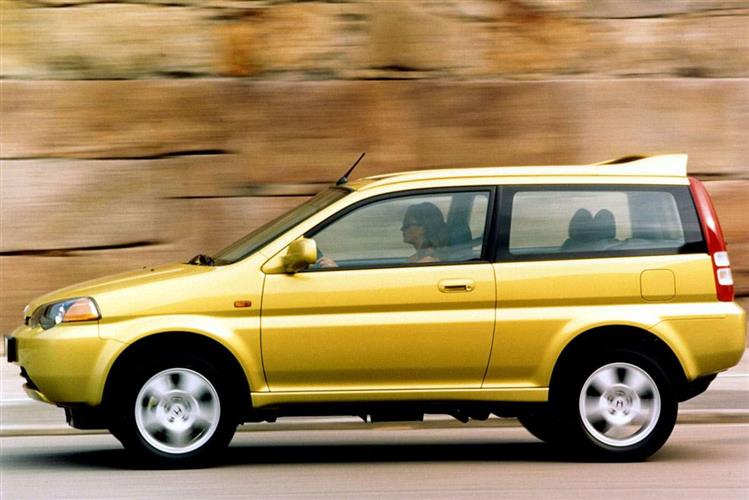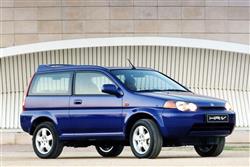TOY MACHINE (some text hidden) --NONE--
BY ANDY ENRIGHT
Introductionword count: 172
Like many models available these days, the Honda HR-V was put into production after receiving favourable feedback as a show car. Despite being more practical than most prototypes, it still retains the image of a trendy plaything. That may well be selling the HR-V short. As rapid urban transport it's pretty good fun. Although offered in two and four wheel drive, it would be a brave, if not foolhardy, driver that chose to take an HR-V mud plugging. The target market for such a vehicle is affluent twenty-somethings who wouldn't dream of getting mud on their Birkenstocks. No, the HR-V looks far more at home outside a gym or trendy eatery, and the driving is experience is more car than jeep-like. Contrary to many perceptions, the HR-V range was never marketed as the Joy Machine. That title was aimed solely at the front-wheel drive models, aiming to create a wacky and fun image. The HR-V moniker stands for High Rider Vehicle, a bland and obvious title that never caught the public's imagination.
Modelsword count: 7
Models Covered: (3/5dr estate 1.6 petrol [2wd/4wd/VTEC])
Historyword count: 275
The HR-V's launch was met with a great deal of head scratching and pondering. What was this thing? It wasn't an MPV, a 'proper' 4x4 or a conventional estate. The best most could do was compare it to the Matra-Simca Rancho of years back. It talked the talk, but couldn't walk the walk, as it were. In the intervening years, the HR-V has become socially rehabilitated. We understand it now. It's just a bit of fun, something from Planet Honda to put a smile on your face. Sales have put a smile on Honda's face too, so whilst used models may be a rare sight on franchised dealer's forecourts, that won't always be the case. The HR-V range was initially launched in February 1999 with just the 105bhp 4wd three-door estate. This was followed in September of the same year by a down-specified front-wheel drive version. A limited edition SE two wheel drive was launched in December 1999 which boasted the same wheels and spoilers as the four-wheel drive model. In early 2000, the five-door model was launched, available only in four-wheel drive. At the same time, Honda offered a 123bhp VTEC engine option for both the three and five-door four-wheel drive models. Therefore, you could never have a five-door front-wheel drive, or a VTEC-engined front-wheel drive. In 2001 the HR-V received a mild facelift, the front becoming slightly beefier, the rear end tidied up a bit and the interior treated to a few flashes of silver. By early 2003 the range had been condensed to just two models - the 1.6-litre CVT and the 1.6-litre VTEC manual. Both were only available in 5-door form.
What You Getword count: 322
Honda is keen to stress that its baby is not an off-road mud-plugger in 4x4 form, though it also claims this version of the HR-V is a 'go-anywhere, do anything vehicle' that's versatile, fun to drive and yet still a sensible choice. As long as 'go-anywhere' excludes terrain that you'd think twice about driving over in the family estate, the description is bang on. In fact, it most closely resembles a small all-wheel drive estate car. The 2WD model is an attractive alternative to the regular three-door Civic, especially if you like a high driving position, and doesn't cost much more than an entry-level 1.4i Civic. Safety has been a priority for the HR-V's designers and the car's bodyshell has been engineered to minimise body deformation and the impact on passengers in an accident. To prevent the high-sided little car from toppling over (like Mercedes' A-class and other tiny but tall town cars had a tendency to do), Honda says it has employed state-of-the-art technology in a number of areas - though the company isn't too specific about what these are. We do know, however, that extensive testing should have produced a chassis usefully resistant towards roll-over tendencies in extreme swerving situations. The cabin is as stylish as the exterior with its large blue speedo and rev counter dials nestling under a deep hood. Like all Hondas, the HR-V's switches and controls are as easy to operate as those on a Fisher-Price child's toy and it's all put together with the precision of a Swiss watch. Essentials include power steering and twin airbags. But it's the creature comforts that make the HR-V seem such good value for money: air conditioning, electric windows and door mirrors, anti-lock brakes, remote central locking and an RDS stereo are all standard kit. On the practical side, both two and four-wheel drive versions will have split/folding rear seats so owners can squeeze long items into the cabin.
To see the full road test text contact us on 0330 0020 227
Pictures (high res disabled)


|
Scoring (subset of scores)
Category: Crossover or SUV 4x4s
| Performance | |
| Handling | |
| Comfort | |
| Space | |
| Styling, Build, Value, Equipment, Depreciation, Handling, Insurance and Total scores are available with our full data feed. | |



